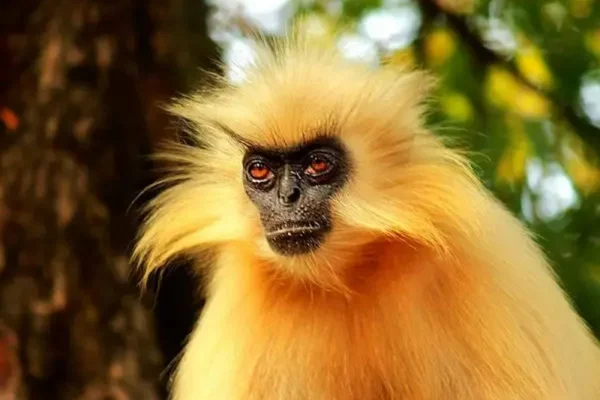There are an estimated 7,396 golden langurs in India, the latest survey of the primate has revealed.
About Golden langur:
- Golden langur (Trachypithecus geei) belongs to the colobines, a large group of Old World monkeys.
- The colobines are leaf-eating primates with a multi-chambered stomach that acts like a ruminant.
- They are found in a small region of Western Assam, India and in the neighboring foothills of the Black Mountains of Bhutan.
- They are a small, diurnal, and arboreal primates primarily reside in the upper canopy of trees.
- They are also known as golden leaf monkeys.
- They were first brought to the attention of the Western world by the naturalist Edward Pritchard Gee in the 1950s.
Habitat:
- Golden langurs live in moist evergreen and tropical deciduous forests, as well as some riverine areas and savannas in Assam and Bhutan.
- Their habitat is limited to the area surrounded by four geographical landmarks: the foothills of Bhutan to the north, Manas River to the east, Sankosh River to the west, and Brahmaputra River to the south.
Characteristics:
- They have a distinctive appearance with hair ranging from dark golden to creamy buff.
- Their faces are black and hairless, except for a long pale beard.
- During winter, their fur takes on a dark golden chestnut hue, while in the summer, it transitions to a lighter, more cream-colored tone.
- Golden langurs are primarily herbivorous, eating leaves, fruit, flowers, seeds, buds, and leguminous shrubs.
Threats:
- Habitat fragmentation and isolation: Deforestation and rural electrification have fragmented the golden langur’s habitat, especially in Assam.
- Poaching: Poaching is another threat to the golden langur.
- Inbreeding: Obstructions like wires and gaps in the forest from felling have increased the risk of inbreeding among golden langurs.
Conservations:
- IUCN: Endangered
- CITES: Appendix I
- Wildlife Protection Act: Schedule-I
- The Golden Langur Conservation Project (GLCP) was started in 1998 to protect the golden langur.
- The GLCP uses community conservation methods to promote sustainable use of forests and agricultural land.
| UPSC IAS Preparation Resources | |
| Current Affairs Analysis | Topperspedia |
| GS Shots | Simply Explained |
| Daily Flash Cards | Daily Quiz |



